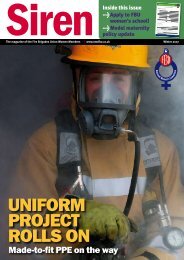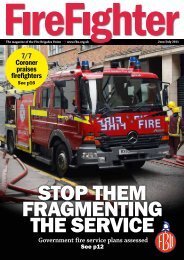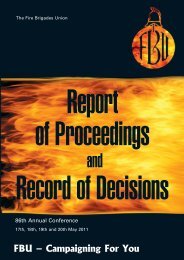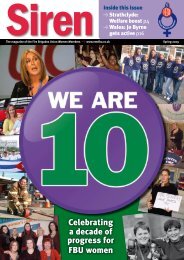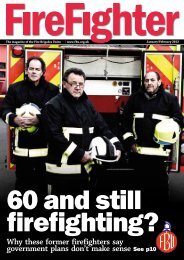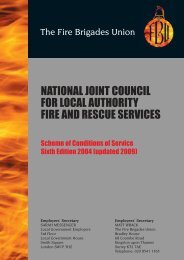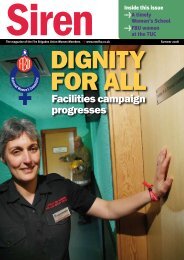Report - Fire Brigades Union
Report - Fire Brigades Union
Report - Fire Brigades Union
Create successful ePaper yourself
Turn your PDF publications into a flip-book with our unique Google optimized e-Paper software.
SECTION B — FIRE AND RESCUE SERVICE POLICY<br />
and there must be a much better dialogue, in particular,<br />
with those outside the core specialist fire safety sector<br />
who are not fire specialists but who in practice are<br />
responsible for delivering fire safety in practice (eg general<br />
design, specification, and construction, owners).<br />
It has been estimated that there are, at least, 4 million<br />
businesses that fall under the <strong>Fire</strong> Safety Order (FSO) and<br />
it is therefore quite clear that the sheer volume and level of<br />
the potential workload is excessive. There is an also<br />
unreasonable expectation that the FRS is equipped and<br />
resourced to take on the burden of advice and policing that<br />
goes with the FSO, and is needed to fully follow through<br />
the enforcement requirements.<br />
It could be considered that the prime role of FSO<br />
enforcement could be delegated, in part or wholly, to the<br />
private sector – and that indeed may be a developing<br />
outcome, however it is unlikely to be a reasonable and<br />
practical, complete solution in the short term. It is<br />
something to be worked towards. Enforcement of the FSO<br />
should remain with the FRS. That is not to say that there is<br />
no role for the industry segment within the fire sector in<br />
backing up the frontline enforcement role of the FRS, and<br />
industry associations are ideally placed through their<br />
contacts with members who are engaged in the market to<br />
act as a watchdog on progress and problems.<br />
One of the greatest challenges for the sector as a whole<br />
is to fully mobilise and apply the collective sector<br />
knowledge that is available. Dissemination of information<br />
and best practice is a growing imperative given the<br />
complexity of the built environment and the challenges that<br />
the varied levels and type of occupancy present across<br />
communities. In that context, central and critical to the<br />
sector knowledge base, is to have a much better database.<br />
Added to this mix of change is also the increasing<br />
development and application of risk-based design<br />
approaches under the banner of fire safety engineering or<br />
expert judgment. Where the building is too big, too<br />
complex, or too innovative to fit comfortably within the<br />
more rigid standard and there is a tendency for the<br />
techniques to be applied, more and more, beyond their<br />
limits of applicability, without adequate scrutiny, and<br />
essentially outside the scope of approved practice. The<br />
concern is that the boundaries are being increasingly<br />
pushed into areas of uncertainty, where applicable<br />
supporting knowledge is at best weak, at worse nonexistent.<br />
The risk is that fire safety margins are being<br />
increasingly squeezed, with much less room for error<br />
should the unexpected happen.<br />
There is undoubtedly an important role for industryendorsed<br />
third party certification schemes. But the<br />
schemes must themselves be fit for stated purpose and<br />
properly accredited. The optimum effect will only be<br />
achieved by officially mandating third party, independent<br />
schemes – or by receiving much wider specifier and client<br />
endorsement by insisting on third party schemes to<br />
mitigate risks by specification.<br />
The core strategy for reducing fire risk through the built<br />
environment should consist of five main elements:<br />
●<br />
●<br />
●<br />
●<br />
●<br />
First improvements can be made through better<br />
application of what is already known.<br />
Second a better understanding of fire behaviour and<br />
building response to fire is required.<br />
Third, there needs to be improved compliance with<br />
regulation, legislation and industry driven best practice.<br />
Fourth, the strategy needs to take a wider view on the<br />
impacts of in line with requirements to lower the costs<br />
of fire damage taking note of community needs.<br />
Finally, there needs to be better collaborative working<br />
for connected fire safety from design to occupation of<br />
the building.<br />
RECOMMENDATIONS – The built environment<br />
There is no need for further legislation, however:<br />
●<br />
●<br />
●<br />
●<br />
The sector should lead on the application of<br />
knowledge, linked to competency, certification, data<br />
sharing and awareness programmes. The Government<br />
should endorse this process and ask that part of the<br />
sector for a formal plan of action.<br />
The programmed review of Approved Document B<br />
should continue, but with a view on new and emerging<br />
practices, as well as broader community needs and the<br />
wider dimensions of fire which are likely to become<br />
more prominent.<br />
Building control should take a proactive co-ordinating<br />
role involving the FRS. To facilitate that agreement it<br />
may be appropriate for a representative building control<br />
body to form a cooperative agreement with CFOA.<br />
The sector should continue to disseminate information<br />
to promote awareness, education, training and<br />
competency accreditation programmes.<br />
4. EVIDENCE-BASED RESPONSE TO RISK<br />
The need to ensure data is freely available and<br />
research properly co-ordinated, is at the centre of<br />
effective risk management.<br />
Data and other evidence is fundamentally important to the<br />
proper delivery of risk based services. We found nothing to<br />
indicate that there is concern about the reporting burden of<br />
data in the <strong>Fire</strong> Sector. Most respondents to our general<br />
survey on knowledge management issues agreed data<br />
collection is necessary to inform better training and<br />
education. There is also a strong demand for greater<br />
pooling and dissemination of information as conducive to<br />
better practice. For instance most agreed that facilitating<br />
co-ordinated access to integrated risk management plans is<br />
essential. There is also a strong belief that incident<br />
recording systems data should be share widely and be<br />
integrated with costs of fire derived from the insurance<br />
sector. The respondents also raised concerns that<br />
experimental data from the <strong>Fire</strong> Experimentation Unit was<br />
not being sufficiently disseminated and that firefighters’<br />
operational knowledge was declining due the prioritisation<br />
FBU Annual <strong>Report</strong> 2011 59





